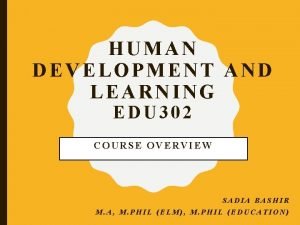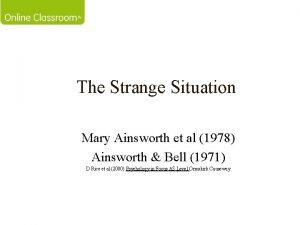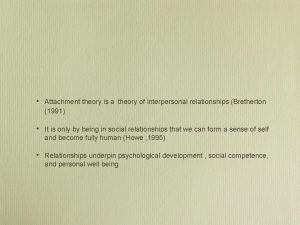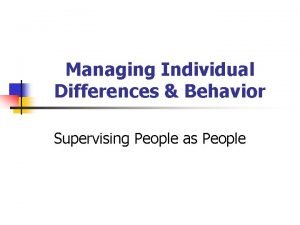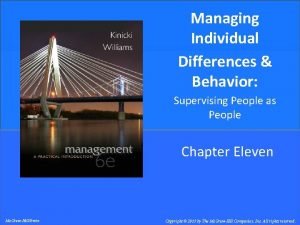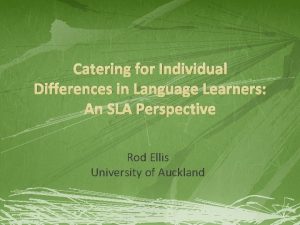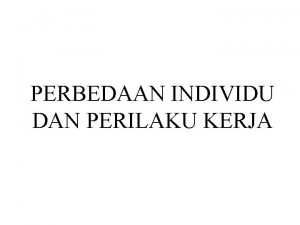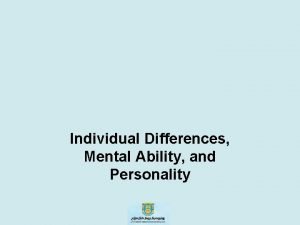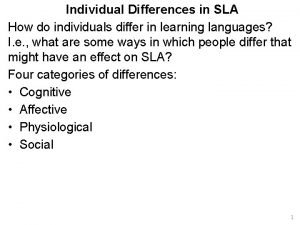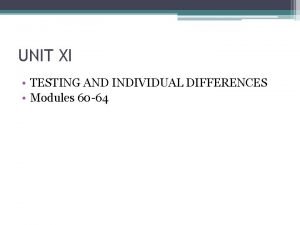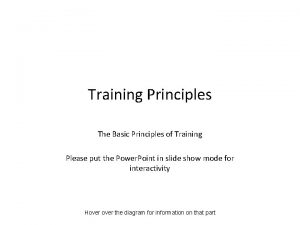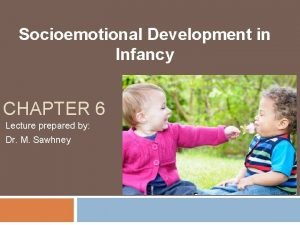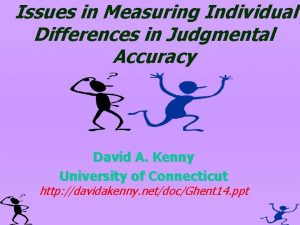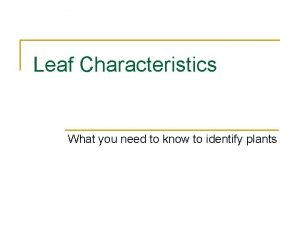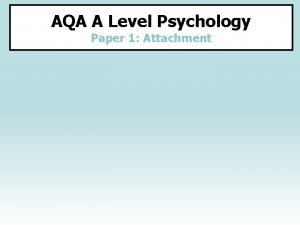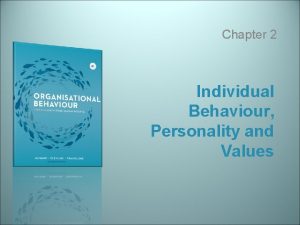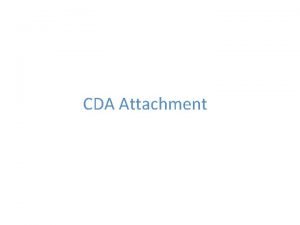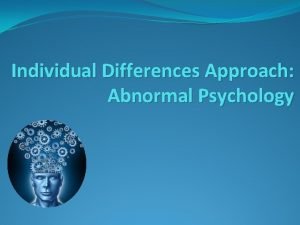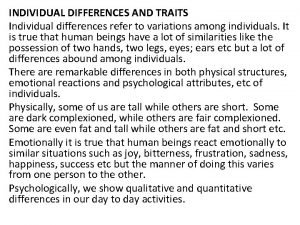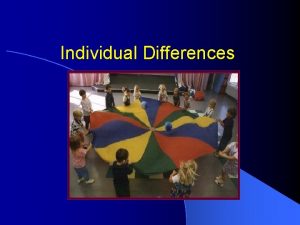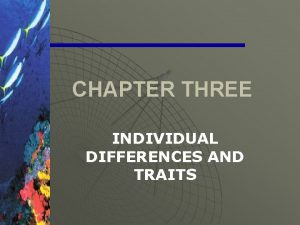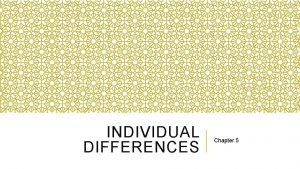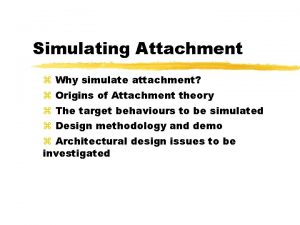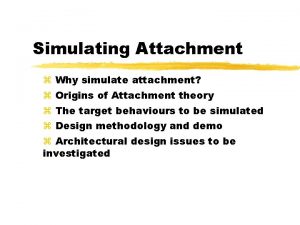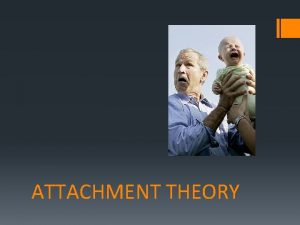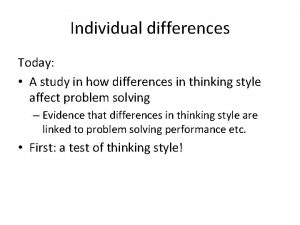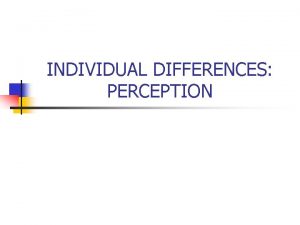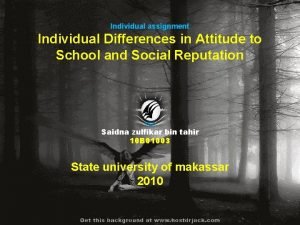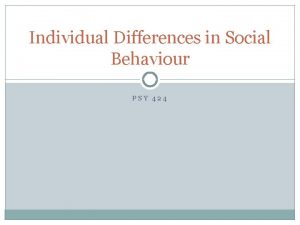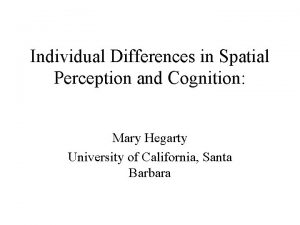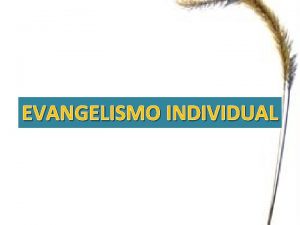Individual Differences in Attachment Types of attachment Mary




















- Slides: 20

Individual Differences in Attachment Types of attachment

Mary Ainsworth Her method of assessing attachment was the strange situation orth w s n i A y r Ma is largely le for responsib work l a n i g i r o the ment h c a t t a n o types Her typology : (classification system) • Secure • Insecure-Avoidant • Insecure-Resistant Both of these are still used today

The Strange Situation – Ainsworth & Bell (1970) Aimed to investigate the individual differences in attachment by seeing how babies reacted in conditions of mild stress (created by separation from primary caregiver and the presence of a stranger) Ainsworth & Bell used a laboratory using structured observations Observing infants aged between 12 -18 months Observed through video cameras Purpose built play room 2 chairs and play area 8 situations Mother, child and stranger



The Strange Situation Series Persons Brief Description 1 Mother & Infant plays, mother sits and reads 2 Mother, Infant & Stranger enters & speak to mother 3 Mother, Infant & Stranger tries to interact with infant 4 Infant & Stranger Mother leaves, stranger comforts 5 Mother & Infant Mother returns, stranger leaves 6 Infant Mother leaves (baby alone in room) 7 Infant & Stranger enters to play/comfort infant 8 Mother & Infant Mother enters, stranger leaves

What were they looking for? ! 1. Separation Anxiety 2. Stranger Anxiety Amount of distress shown when caregiver briefly leaves Amount of distress shown in response to a stranger 3. Reunion Behaviour 4. Willingness to explore Behaviour on being reunited with caregiver Whether the infant feels they have a ‘secure base’ to explore environment

What did they find? ! Ainsworth et al identified 3 main attachment types Securely Attached (70%) Infant explores the environment, using caregiver as secure base. Infant shows moderate distress when separated but is easily soothed, infant is wary of stranger. Insecure-Avoidant(15%) Infant does not attempt to interact with mother, do not show anxiety when left with stranger. No reunion behaviour when mother returns, infants will explore but doesn’t orientate to mother Insecure-Resistant (15%) Infant is very distressed when separated, difficult to console on reunion. Infant rushes to mother but may show anger. Infant ignores stranger, limited exploration of environment

Summarise Ainsworth’s findings Separation Anxiety Secure Some but easily soothed Stranger Anxiety Reunion Behaviour Exploration High Enthusiastic, easy to soothe High Low Insecure. Avoidant Indifferent Low Avoids contact – doesn’t seek contact Insecure. Resistant Distressed High Seeks and rejects (using Mother as secure base)

Ainsworth A 02 - Positive Lots of detail quickly Why is this a good thing? For example, a huge number of research studies into attachment behaviour adopt a longitudinal approach which can take months or even years to draw conclusions

Ainsworth A 02 - Negative Lacks ecological validity Why is this a bad thing? What does this mean? For example, the ‘playroom’ environment in which the infant was interacting was both strange and unfamiliar to the infants

Ainsworth A 02 - Negative Ethical Issues Why is this a bad thing? For example, in episode 6 (which one is that? ) 20% of the infants reportedly cried ‘desperately’, clearly showing their distress

Ainsworth A 02 - Negative The classification system doesn’t fit all infants Why is this a bad thing? For example, Main & Solomon (1986) added a fourth type ‘D’ attachment which was for babies who were inconsistent and clearly didn’t fit Ainsworth’s A, B or C


Affects and Effects • Affecting factors in attachment types • Effect of attachment types on later life

Factors that can affect the type of attachment Sensitivity Hypothesis Temperament Hypothesis

Sensitivity Hypothesis The Mother Ainsworth argued that mothers who were sensitive to their infants’ needs, who could read their moods/feelings and respond to them effectively were more likely to produce securely attached infants In contrast, mothers who were less sensitive and responsive to their infants, who ignored them or were impatient were more likely to have insecurely attached infants

Temperament Hypothesis The Infant Kagan argued Ainsworth’s explanation placed too much emphasis on the role of the mother and ignored the natural innate temperament of the child. According to this hypothesis, infants are born with different individual characteristics relating to how active, emotional and sociable they are naturally. It is this rather than the mother that dictates the attachment type

How early attachment types shape adult behaviour Behaviour at school Adult romantic behaviour

Behaviour at school Children who are securely attached explore their environment more, are better able to deal with challenging situations and are more adept at problem solving. Insecure-avoidant children often develop behavioural issues and lack persistence in learning Adult romantic behaviour Hazen & Shaver (1987) – The Luuuurvve Quiz Adults who were securely attached as infants find it relatively easy to get close to others and are comfortable depending on others and having others depend on them. Insecure avoidant adults are uncomfortable being close to others.
 Growth and development
Growth and development Mary ainsworth styles of attachment
Mary ainsworth styles of attachment Signs of avoidant attachment
Signs of avoidant attachment Managing individual differences and behavior
Managing individual differences and behavior Managing individual differences and behavior
Managing individual differences and behavior Individual differences factors
Individual differences factors Catering for individual differences
Catering for individual differences Makalah perbedaan individu dan perilaku kerja
Makalah perbedaan individu dan perilaku kerja Gambar perbedaan individu
Gambar perbedaan individu Individual differences factors
Individual differences factors Individual differences in sla
Individual differences in sla Unit xi testing and individual differences
Unit xi testing and individual differences Principle of training variation
Principle of training variation Principles of training individual differences
Principles of training individual differences Thomas and chess temperament
Thomas and chess temperament Conclusion of individual differences
Conclusion of individual differences Mary wollstonecraft mary a fiction
Mary wollstonecraft mary a fiction Incised leaf
Incised leaf Psychology aqa a level spec
Psychology aqa a level spec Explain individual behaviour
Explain individual behaviour Types of individual multilingualism
Types of individual multilingualism
